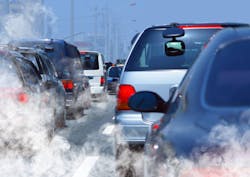Trump Safety Pitch for Easing Car Standards Rebutted by Study
President Donald Trump’s plan to freeze U.S. vehicle efficiency standards would result in higher costs for motorists without doing anything to boost highway safety, according to an analysis by Consumer Reports that undermines the administration’s chief talking points in favor of the move.
The analysis comes as the White House reviews a final drafted plan for easing vehicle emissions and fuel economy standards, despite escalating pressure from some automakers and California to change course. The administration last year proposed capping fuel economy and tailpipe carbon dioxide emission standards at 2020 levels, instead of allowing them to become stricter each year as under existing regulations. The plan also calls for stripping California of its authority to regulate tailpipe greenhouse gas emissions.
The Transportation Department and Environmental Protection Agency argued their proposal would pare the cost of new automobiles and save as many as 1,000 lives annually by spurring motorists to trade in older models for newer, safer vehicles. The agencies estimated the proposal would spare motorists some $2,340 in average new vehicle ownership costs. They combined those forecasts into the name of the measure, dubbed the “Safer Affordable Fuel Efficient Vehicles”ーor SAFE Vehiclesーproposal.
But the Consumer Reports analysis counters the administration’s assertions that the plan would reduce traffic fatalities and boost highway safety. Consumer Reports argues instead that “the effects on safety from changes in fuel-economy standards are quite small and likely not statistically different from zero.”
That assessment dovetails with concerns raised quietly by EPA officials last year, as the administration prepared to unveil its plan. At the time, EPA regulators repeatedly questioned the underlying safety assumptions, at least once warning that the proposed standards would actually be “detrimental to safety.”
Representatives of the EPA and Transportation Department did not immediately respond to emailed requests for comment.
The Consumer Reports analysis also paints a starkly different picture of potential costs for drivers, by highlighting the importance of fuel savingsーrather than vehicle purchase pricesーto motorists. Because most new vehicle buyers finance their purchases, they can start feeling the benefits of lower fuel costs right away, the organization says.
And those fuel savings, in turn, drive higher consumer spending and more purchases of newer, safer vehicles, said the group, the advocacy arm of the consumer product research and testing not-for-profit that publishes Consumer Reports magazine.
“The rollback is like a gas tax because it increases drivers’ fuel costs,” said Consumer Reports, likening the proposed policy change to an additional 63 cents per gallon of gasoline for owners of model year 2026 vehicles over potential costs under existing policy. Over the life of that 2026 automobile, the administration’s policy choice would translate to $3,300 in forgone savings, the analysis found. The owners of trucks and sport utility vehicles would be especially hard hit, according to the assessment.
“The last thing the federal government should be doing is burdening consumers with more costs, while thwarting progress in the development of cleaner cars,” said Shannon Baker-Branstetter, a manager of cars and energy policy at Consumer Reports who co-authored the analysis.
Consumer Reports compared the administration’s proposal with existing standards enacted by the Obama administration. However, supporters of the effort say it’s unclear automakers will be able to satisfy the Obama-era requirements. They say, the surging popularity of sport-utility vehicles and other trucks has made existing mileage requirements harder to satisfy, while raising the cost of new vehicles and putting them out of reach for many households.
The administration has acknowledged a link between its plan and higher fuel consumption, saying its proposal could cause the U.S. to use an extra 500,000 barrels of oil daily.
Carmakers have pleaded with administration officials to restart negotiations with California over the standards, arguing that the changes could lead to years of uncertainty and a split market in which federal mileage requirements would govern most states, while California-backed rules would apply in states that account for more than a third of U.S. auto sales.
Four major automakers said last month they had reached a compromise with California to voluntarily boost fuel efficiency, a move seen aimed at pressuring the administration to shift course.
By Jennifer A. Dlouhy
About the Author
Bloomberg
Licensed content from Bloomberg, copyright 2016.
